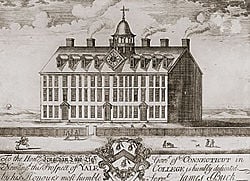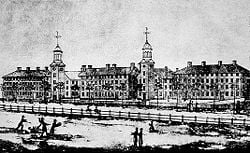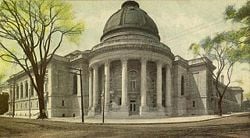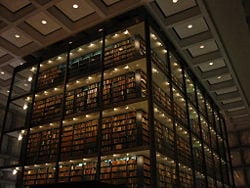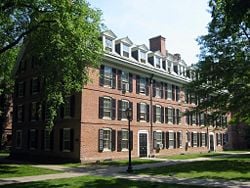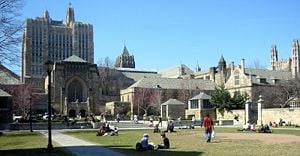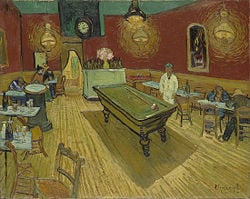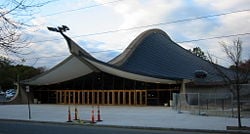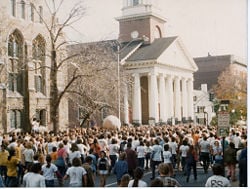Yale University
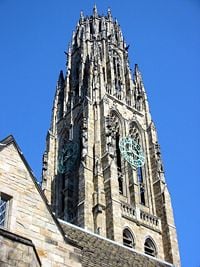
| |
| Motto | Urim and Thummim
אורים ותמים (Hebrew) |
|---|---|
| Established | 1701 |
| Type | Private |
| Location | New Haven, Connecticut USA |
| Website | www.yale.edu |
Yale University is a private university in New Haven, Connecticut. Founded in 1701 as the Collegiate School, Yale is the third-oldest institution of higher education in the United States and is a member of the Ivy League. Yale and Harvard have been rivals in almost everything for most of their history, notably academics, rowing and American football.
Yale uses a residential college housing system modeled after those at Oxford and Cambridge. Each of 12 residential colleges houses a representative cross-section of the undergraduate student body, and features facilities, seminars, resident faculty, and support personnel. Women were admitted to the graduate school in 1892, but the university did not become fully coeducational until 1969. Yale, like the other Ivy League schools, remains highly selective in admissions and is rated among the nation's top schools in terms of academic and social prestige. The school has produced leaders and visionaries in every area from art to politics.
Yale is confident that it can significantly impact the world for the better, based on its tangible assets, human resources, and internal culture that support its dedication to the preservation, transmission, and advancement of knowledge. However, for Yale to truly serve the world through its outstanding research programs and education of leaders, attention must be paid not only to the mastery of knowledge and skills, but also to understanding of the heart and spirit of humankind.
Mission & Reputation
Yale was originally founded to continue the European tradition of liberal education in America.
The school has since grown to one of the leading universities in almost every field imaginable from the sciences to the humanities. Particularly well-known are its undergraduate school, Yale College, and the Yale Law School, each of which has produced a number of U.S. presidents and foreign heads of state. Also notable is the Yale School of Drama, which has produced many prominent Hollywood and Broadway actors and writers, as well as the art, divinity, forestry and environment, music, medical, management, nursing and architecture schools, each of which is often cited as among the finest in its field.
Yale president Richard C. Levin summarized the university's institutional priorities for its fourth century:
First, among the nation's finest research universities, Yale is distinctively committed to excellence in undergraduate education. Second, in our graduate and professional schools, as well as in Yale College, we are committed to the education of leaders.[1]
History
Yale was founded to train ministers. It traces its beginnings to "An Act for Liberty to Erect a Collegiate School" passed by the General Court of the Colony of Connecticut and dated October 9, 1701. Soon thereafter, a group of ten Congregationalist ministers led by James Pierpont, all of whom were Harvard alumni (Harvard having been the only college in North America when they were school-aged), met in Branford, Connecticut, to pool their books to form the school's first library.[2] The group is now known as "The Founders."
Originally called the Collegiate School, the institution opened in the home of its first rector, Abraham Pierson, in Killingworth (now Clinton). It later moved to Saybrook, and then Wethersfield. In 1718, the college moved to New Haven, Connecticut, where it remains to this day.
In the meanwhile, a rift was forming at Harvard between its sixth president Increase Mather (Harvard A.B., 1656) and the rest of the Harvard clergy, which Mather viewed as increasingly liberal, ecclesiastically lax, and overly broad in Church polity. The relationship worsened after Mather resigned, and the administration repeatedly rejected his son and ideological colleague, Cotton Mather (Harvard A.B., 1678), for the position of the Harvard presidency. The feud caused the Mathers to champion the success of the Collegiate School in the hopes that it would maintain the Puritan religious orthodoxy in a way that Harvard had not.[3]
In 1718, at the behest of either Rector Andrew or Governor Gurdon Saltonstall, Cotton Mather contacted a successful businessman in Wales named Elihu Yale to ask him for financial help in constructing a new building for the college. Yale, who had made a fortune through trade while living in India as a representative of the East India Company, donated nine bales of goods, which were sold for more than £560, a substantial sum at the time. Yale also donated 417 books and a portrait of King George I. Cotton Mather suggested that the school change its name to Yale College in gratitude to its benefactor, and to increase the chances that he would give the college another large donation or bequest. Elihu Yale was away in India when the news of the school's name change reached his home in Wrexham, North Wales, a trip from which he never returned. And while he did ultimately leave his fortunes to the "Collegiate School within His Majesties Colony of Connecticot," the institution was never able to successfully lay claim to it.
Serious American students of theology and divinity, particularly in New England, regarded Hebrew as a classical language, along with Greek and Latin, and essential for study of the Old Testament in the original words. The Reverend Ezra Stiles, president of the College from 1778 to 1795, brought with him his interest in the Hebrew language as a vehicle for studying ancient Biblical texts in their original language (as was common in other schools), requiring all freshmen to study Hebrew (in contrast to Harvard, where only upperclassmen were required to study the language) and is responsible for the Hebrew words "Urim" and "Thummim" on the Yale seal. Stiles' greatest challenge occurred in July, 1779 when hostile British forces occupied New Haven and threatened to raze the College. Fortunately, Yale graduate Edmund Fanning, Secretary to the British General in command of the occupation, interceded and the College was saved. Fanning later was granted an honorary degree for his efforts.
Yale College expanded gradually, establishing the Yale School of Medicine (1810), Yale Divinity School (1822), Yale Law School (1843), Yale Graduate School of Arts and Sciences (1847), the Sheffield Scientific School (1861), and the Yale School of Fine Arts (1869). (The divinity school was founded by Congregationalists who felt that the Harvard Divinity School had become too liberal. This is similar to the Oxbridge rivalry in which dissident scholars left University of Oxford to form the University of Cambridge) In 1887, as the college continued to grow under the presidency of Timothy Dwight V, Yale College was renamed to Yale University. The university would later add the Yale School of Music (1894), Yale School of Forestry & Environmental Studies (1901), Yale School of Public Health (1915), Yale School of Nursing (1923), Yale Physician Associate Program (1973), and Yale School of Management (1976). It would also reorganize its relationship with the Sheffield Scientific School.
In 1966, Yale initiated discussions with its sister school Vassar College concerning the possibility of a merger as an effective means to achieve coeducation. However, Vassar declined Yale's invitation and, ultimately, both Yale and Vassar decided to remain separate and introduce coeducation independently in 1969.[4] Amy Solomon was the first woman to register as a Yale undergraduate;[5] she was also the first woman at Yale to join an undergraduate society, St. Anthony Hall. (Women studied at Yale University as early as 1876, but in graduate-level programs at the Yale Graduate School of Arts and Sciences.)
Yale, like other Ivy League schools, instituted policies in the early twentieth century designed artificially to increase the proportion of upper-class white Christians of notable families in the student body, and was one of the last of the Ivies to eliminate such preferences, beginning with the class of 1970.[6]
The President and Fellows of Yale College, also known as the Yale Corporation, is the governing board of the University.
Education
Yale's 70 undergraduate majors are primarily focused on a liberal curriculum, and few of the undergraduate departments are pre-professional in nature. About 20 percent of Yale undergraduates major in the sciences, 35 percent in the social sciences, and 45 percent in the arts and humanities.[7] All tenured professors teach undergraduate courses, more than 2,000 of which are offered annually.
Yale's English and Literature departments were part of the New Criticism movement. Of the New Critics, Robert Penn Warren, W.K. Wimsatt, and Cleanth Brooks were all Yale faculty. Later, after the passing of the New Critical fad, the Yale literature department became a center of American deconstruction, with French and Comparative Literature departments centered around Paul de Man and supported by the English department. This has become known as the "Yale School." Yale's history department has also originated important intellectual trends. Historian C. Vann Woodward is credited for beginning in the 1960s an important stream of southern historians; likewise, David Montgomery, a labor historian, advised many of the current generation of labor historians in the country. Most noticeably, a tremendous number of currently active Latin American historians were trained at Yale in the 1960s, 1970s, and 1980s by Emìlia Viotta da Costa; younger Latin Americanists tend to be "intellectual cousins" in that their advisors were advised by the same people at Yale.
Facilities
Yale architecture
Yale is noted for its harmonious yet fanciful largely Collegiate Gothic campus[8] as well as for several iconic modern buildings commonly discussed in architectural history survey courses: Louis Kahn's Yale Art Gallery[9] and Center for British Art, Eero Saarinen's Ingalls Rink and Ezra Stiles and Morse Colleges, and Paul Rudolph's Art & Architecture Building. Yale also owns many noteworthy nineteenth-century mansions along Hillhouse Avenue.
Many of Yale's buildings were constructed in the neo-Gothic architecture style from 1917 to 1931. Stone sculpture built into the walls of the buildings portray contemporary college personalities such as a writer, an athlete, a tea-drinking socialite, and a student who has fallen asleep while reading. Similarly, the decorative friezes on the buildings depict contemporary scenes such as policemen chasing a robber and arresting a prostitute (on the wall of the Law School), or a student relaxing with a mug of beer and a cigarette. The architect, James Gamble Rogers, faux-aged these buildings by splashing the walls with acid,[10] deliberately breaking their leaded glass windows and repairing them in the style of the Middle Ages, and creating niches for decorative statuary but leaving them empty to simulate loss or theft over the ages. In fact, the buildings merely simulate Middle Ages architecture, for though they appear to be constructed of solid stone blocks in the authentic manner, most actually have steel framing as was commonly used in 1930. One exception is Harkness Tower, 216 feet tall, which was originally a free-standing stone structure. It was reinforced in 1964 to allow the installation of the Yale Memorial Carillon.
Other examples of the Gothic (also called neo-Gothic and collegiate Gothic) style are on Old Campus by such architects as Henry Austin, Charles C. Haight and Russell Sturgis. Several are associated with members of the Vanderbilt family, including Vanderbilt Hall,[11] Phelps Hall,[12] St. Anthony Hall (a commission for member Frederick William Vanderbilt), the Mason, Sloane and Osborn laboratories, dormitories for the Sheffield Scientific School (the engineering and sciences school at Yale until 1956) and elements of Silliman College, the largest residential college.[13]
Ironically, the oldest building on campus, Connecticut Hall (built in 1750), is in the Georgian style and appears much more modern. Georgian-style buildings erected from 1929 to 1933 include Timothy Dwight College, Pierson College, and Davenport College, except the latter's east, York Street façade, which was constructed in the Gothic style.
The Beinecke Rare Book and Manuscript Library, designed by Gordon Bunshaft of Skidmore, Owings, and Merrill, is one of the largest buildings in the world reserved exclusively for the preservation of rare books and manuscripts.[14] It is located near the center of the University in Hewitt Quadrangle, which is now more commonly referred to as "Beinecke Plaza." The library's six-story above-ground tower of book stacks is surrounded by a windowless rectangular building with walls made of translucent Vermont marble, which transmit subdued lighting to the interior and provide protection from direct light, while glowing from within after dark.
The sculptures in the sunken courtyard by Isamu Noguchi are said to represent time (the pyramid), the sun (the circle), and chance (the cube).
Alumnus Eero Saarinen, Finnish-American architect of such notable structures as the Gateway Arch in St. Louis, Washington Dulles International Airport main terminal, and the CBS Building in Manhattan, designed Ingalls Rink at Yale and the newest residential colleges of Ezra Stiles and Morse. These latter were modelled after the medieval Italian hilltown of San Gimignano — a prototype chosen for the town's pedestrian-friendly milieu and fortress-like stone towers. These tower forms at Yale act in counterpoint to the college's many Gothic spires and Georgian cupolas.[15]
Notable nonresidential campus buildings
Notable nonresidential campus buildings and landmarks include:
- Sterling Memorial Library
- Harkness Tower
- Woolsey Hall
- Beinecke Rare Book Library
- Yale University Art Gallery
- Yale Center for British Art
- Payne Whitney Gymnasium
- Ingalls Rink
- Battell Chapel
- Yale Art & Architecture Building
- Osborne Memorial Laboratories
- Sterling Hall of Medicine
- Sterling Law Buildings
- Kline Biology Tower
- Peabody Museum of Natural History
Yale's secret societies, whose buildings (some of which are called "tombs") were built both to be intensely private yet ostentatiously theatrical, display diversity and fancifulness of architectural expression, include:
- Berzelius, Don Barber in an austere cube with classical detailing (erected in 1908 or 1910).
- Book and Snake, Louis R. Metcalfe in a Greek Ionic style (erected in 1901).
- Elihu, architect unknown but built in a Colonial style (constructed with an early seventeenth century foundation and while the building is from eighteenth century).
- Manuscript Society, King Lui-Wu with Dan Kniley responsible for landscaping and Joseph Albers for the brickwork intaglio mural. Building constructed in a mid-century modern style.
- Scroll and Key, Richard Morris Hunt in a Moorish- or Islamic-inspired Beaux-Arts style (erected 1869–1870).
- Skull and Bones, possibly Alexander Jackson Davis or Henry Austin in an Egypto-Doric style utilizing Brownstone (in 1856 the first wing was completed, in 1903 the second wing, 1911 the Neo-Gothic towers in rear garden were completed).
- St. Anthony Hall, (Charles C. Haight in a neo-Gothic style (erected circa 1913 to match the flanking donated dormitories {dated 1903–1906} now part of Silliman College).
- Wolf's Head, Bertram Grosvenor Goodhue (erected in the 1920s).
Collections
Yale University Library is the second-largest university collection in the world with a total of almost 11 million volumes. The main library, Sterling Memorial Library, contains about four million volumes, and other holdings are dispersed at a variety of subject libraries.
Rare books are found in a number of Yale collections. The Beinecke Rare Book Library has a large collection of rare books and manuscripts. The Harvey Cushing/John Hay Whitney Medical Library includes important historical medical texts, including an impressive collection of rare books, as well as historical medical instruments. The Lewis Walpole Library contains the largest collection of eighteenth century British literary works. And the Elizabethan Club, while technically a private organization, makes its Elizabethan folios and first editions available to qualified researchers through Yale.
Yale's museum collections are also of international stature. The Yale University Art Gallery is the country's first university-affiliated art museum. It contains important collections of modern art as well as Old Masters, with over 180,000 total works. The works are housed in the Swartout and Kahn buildings. The latter, Louis Kahn's first large-scale American work (1953), was recently renovated and reopened in December 2006. The Yale Center for British Art is the largest collection of British art outside of the UK, originally the gift of Paul Mellon and also housed in a building designed by Louis Kahn.
The Peabody Museum of Natural History is New Haven's most popular museum, well-used by school children as well as containing research collections in anthropology, archaeology, and the natural environment. The Yale University Collection of Musical Instruments, affiliated with the Yale School of Music, is perhaps the least well-known of Yale's collections, because its hours of opening are restricted.
Student Life
Yale College students come from a variety of ethnic, national, and socio-economic backgrounds. Of the 2006-2007 freshman class, 9 percent are international students, while 54 percent went to public high schools.[16]Minority students are visible and active in numerous cultural organizations, several cultural houses, and campus events.
Yale is also an open campus for the gay community. Its active LGBT community first received wide publicity in the late 1980s, when Yale obtained a reputation as the "gay Ivy," due largely to a 1987 Wall Street Journal article written by Julie V. Iovine, an alumna and the spouse of a Yale faculty member. During the same year, the University hosted a national conference on gay and lesbian studies and established the Lesbian and Gay Studies Center.[17]The slogan "One in Four, Maybe More; One in Two, Maybe You" was coined by the campus gay community. While the community in the 1980s and early 1990s was very activist, today most LGBT events have become part of the general campus social scene. For example, the annual LGBT Co-op Dance attracts both homosexual and straight students. The strong programs at the School of Music, School of Drama, and School of Art also thrive.
Campus cultural life features many concerts, shows, recitals, and operas.
Residential colleges
Yale has a system of 12 residential colleges, instituted in 1933 through a grant by Yale graduate Edward S. Harkness, who admired the college systems at Oxford and Cambridge. Each college has a carefully constructed support structure for students, including a Dean, Master, affiliated faculty, and resident Fellows. Each college also features distinctive architecture, secluded courtyards, and facilities ranging from libraries to squash courts to darkrooms. While each college at Yale offers its own seminars, social events, and Master's Teas with guests from the world, Yale students also take part in academic and social programs across the university, and all of Yale's 2,000 courses are open to undergraduates from any college.
Residential colleges are named for important figures or places in university history or notable alumni; they are deliberately not named for benefactors.
In 1990, Yale launched a series of massive renovations to the older residential buildings, whose decades of existence had seen only routine maintenance and incremental improvements to plumbing, heating, and electrical and network wiring. Renovations to many of the colleges are now complete, and among other improvements, renovated colleges feature newly built basement facilities including restaurants, game rooms, theaters, athletic facilities and music practice rooms.
In 2006, the Yale administration began evaluating the feasibility of building two new residential colleges.[18]
Sports
Yale supports 35 varsity athletic teams that compete in the Ivy League Conference, the Eastern College Athletic Conference, the New England Intercollegiate Sailing Associaton, and Yale is an NCAA Division I member. Like other members of the Ivy League, Yale does not offer athletic scholarships and is no longer competitive with the top echelon of American college teams in the big-money sports of basketball and football. Nevertheless, American football was largely created at Yale by player and coach Walter Camp, who evolved the rules of the game away from rugby and soccer in the late nineteenth and early twentieth centuries. Yale has numerous athletic facilities, including the Yale Bowl (the nation's first natural "bowl" stadium, and prototype for such stadiums as the Los Angeles Memorial Coliseum and the Rose Bowl), located at The Walter Camp Field athletic complex, and the Payne Whitney Gymnasium, the second-largest indoor athletic complex in the world.[19]
October 21st, 2000 marked the dedication of Yale's fourth new boathouse in 157 years of collegiate rowing. The Gilder Boathouse is named to honor former Olympic rower Virginia Gilder '79 and her father Richard Gilder '54, who gave $4 million towards the $7.5 million project. Yale also maintains the Gales Ferry site where the heavyweight men's team trains for the prestigious Yale-Harvard Boat Race. Yale crew is the oldest collegiate athletic team in America, and today Yale Rowing boasts lightweight men, heavyweight men, and a women's team. All of an internationally competitive caliber.
The Yale Corinthian Yacht Club, founded in 1881, is the oldest collegiate sailing club in the world. The yacht club, located in nearby Branford, Connecticut, is the home of the Yale Sailing Team, which has produced several Olympic sailors.
Mascot
The school mascot is "Handsome Dan," the famous Yale bulldog, and the Yale fight song (written by alumnus Cole Porter) contains the refrain, "Bulldog, bulldog, bow wow wow." The school color is Yale Blue.
Yale athletics are supported by the Yale Precision Marching Band. The marching band attends every home football game and many away, as well as most hockey and basketball games throughout the winter.
Yale intramural sports are a vibrant aspect of student life. Students compete for their respective residential colleges, which fosters a friendly rivalry. The year is divided into fall, winter, and spring seasons, each of which includes about ten different sports. About half the sports are coed. At the end of the year, the residential college with the most points (not all sports count equally) wins the Tyng Cup.
Student organizations
There are a large number of student organizations.
The Yale Political Union, the oldest student political organization in the United States, is often the largest organization on campus, and is advised by alumni political leaders such as John Kerry and George Pataki.
The university hosts a variety of student journals, magazines, and newspapers. The latter category includes the Yale Daily News, which was first published in 1878 and is the oldest daily college newspaper in the United States, as well as the weekly Yale Herald, first published in 1986. Dwight Hall, an independent, non-profit community service organization, oversees more than 2,000 Yale undergraduates working on more than 60 community service initiatives in New Haven. The Yale College Council runs several agencies that oversee campus wide activities and student services. The Yale Dramatic Association and Bulldog Productions cater to the theater and film communities, respectively.
The campus also includes several fraternities and sororities. The campus features at least 18 a capella groups, the most famous of which is The Whiffenpoofs, who are unusual among college singing groups in being made up solely of senior men. A number of prominent senior societies, including Skull and Bones, Scroll and Key and Wolf's Head, are composed of Yale College seniors.
Traditions
- Yale students claim to have invented Frisbee, by tossing around empty pie tins from the Frisbie Pie Company.
- Another traditional Yale game was bladderball, played between 1954 and 1982. A game started in 1954 as a prelude to the Yale-Dartmouth football game, bladderball pitted several campus organizations against each other in a struggle for a giant inflated ball. The event inspired near riots and a few outrageous hijinks until it was banned in 1982, after a spate of serious injuries resulting from participation in the event.[20]
- Yale's Handsome Dan is believed to be the first live college mascot in America, having been established in 1889.
- Yale's student tour guides tell visitors that students consider it good luck to rub the toe of the statue of Theodore Dwight Woolsey on Old Campus. Actual students rarely do so.[21]
- Yale seniors at graduation smash clay pipes underfoot to symbolize passage from their "bright college years."
Controversies
Yale alumnus William F. Buckley's 1951 book, God and Man at Yale, criticized Yale for indoctrinating liberalism, undermining Christianity, and failing to dismiss radical professors.
Yale claims to be less reliant on teaching assistants in undergraduate education than many of its peer institutions. On the other hand, some graduate students have criticized Yale for an over-reliance on teaching assistants, claiming that when measured on a time per student basis, graduate teaching assistants do a majority of teaching at Yale.[22] In comparison with its peer institutions, Yale senior faculty perform an unusually high amount of undergraduate teaching and are generally praised for being extremely accessible and interested in undergraduates. All tenured professors in the Faculty of Arts and Sciences teach undergraduate courses,[23] and courses taught primarily by graduate students account for only 7% of total enrollments.[24]
In 2001, three Yale graduate students published a report detailing Yale's historical connections with slavery.[25] The report noted that nine of Yale's residential colleges are named for slave owners or proponents of slavery such as John C. Calhoun; it also noted prominent abolitionists such as James Hillhouse associated with the university.
Notable Alumni
Yale's 300 years of history has produced many notable alumni including presidents George H. W. Bush, Bill Clinton (who attended the University's Law School along with his wife, New York Senator Hillary Clinton), and George W. Bush, and Vice President Dick Cheney, (although he did not graduate). Many of the 2004 presidential candidates attended Yale: Bush, John Kerry, Howard Dean, and Joe Lieberman.
Other Yale-educated presidents were William Howard Taft (B.A.) and Gerald Ford (LL.B). Alumni also include several Supreme Court justices, including current Justices Clarence Thomas and Samuel Alito.
Yale counts 29 Nobel Prize laureates among its alumni including:
- George Akerlof (B.A. 1962). Economics, 2001.[26]
- Raymond Davis Jr. (Ph.D. 1942).[27] Physics, 2002.
- John F. Enders (B.A. 1920).[28] Physiology or Medicine, 1954.
- John Fenn (Ph.D. 1940).[29][30] Chemistry, 2002.
- Murray Gell-Mann (B.S. 1948).[31] Physics, 1969.
- Alfred G. Gilman (B.S. 1962).[32] Physiology or Medicine, 1994.
- Ernest Lawrence (Ph.D. 1925).[33] Physics, 1939. Lawrence Livermore National Laboratory & Lawrence Berkeley National Laboratory are named for him.[34]
- Joshua Lederberg (Ph.D. 1948).[35] Physiology or Medicine, 1958.
- David Lee (Ph.D. 1959).[36] Physics, 1996.
- Sinclair Lewis (B.A. 1908).[37] Literature, 1930.
- Lars Onsager (Ph.D. 1935).[38] Chemistry, 1968.
- Edmund Phelps (Ph.D. 1959). Economics, 2006.
- Dickinson W. Richards (B.A. 1917).[39] Physiology or Medicine, 1956.
- William Vickrey (B.S. 1935).[40] Economics, 1996.
- George Whipple (A.B. 1900).[41] Physiology or Medicine, 1934.
- Eric Wieschaus (Ph.D. 1974).[42] Physiology or Medicine, 1995.
Beyond these, Yale has graduated many Pulitzer Prize winners, actors, politicians, businessmen, activists, and scholars.
Notes
- ↑ Yale Alumni Magazine "Preparing for Yale's Fourth Century." Retrieved April 10, 2007.
- ↑ The Harvard Crimson "I'm Gonna Git YOU Sukka: Classic Stories of Revenge at Harvard." Retrieved April 10, 2007.
- ↑ [http://college.hmco.com/history/readerscomp/rcah/html/ah_057300_matherincrea.htm Increase Mather, in the Encyclopædia Britannica Eleventh Edition. Retrieved August 4, 2007.
- ↑ Vassar Encyclopedia A History of the Curriculum 1865-1970s Retrieved August 4, 2007.
- ↑ Yale Bulletin and Calendar "Transformations brought about by Yale women." Retrieved April 10, 2007.
- ↑ Yale Alumni Magazine: "The Birth of a New Institution." Retrieved April 10, 2007.
- ↑ Yale University "Some Facts & Statistics About Yale University." Retrieved April 10, 2007.
- ↑ Assorted pictures of Yale's campus. Retrieved April 10, 2007.
- ↑ About the Yale Art Gallery. Retrieved April 10, 2007.
- ↑ Yale Herald: "Donor steps up to fund CCL renovations." Retrieved April 10, 2007.
- ↑ Vanderbilt Hall Retrieved August 4, 2007.
- ↑ Phelps Hall.
- ↑ Silliman College Retrieved August 4, 2007.
- ↑ Beinecke Rare Book Library "About the Library Building." Retrieved April 10, 2007.
- ↑ Assorted pictures of Ezra Stiles College. Retrieved April 10, 2007.
- ↑ [1] Retrieved July 11, 2008.
- ↑ [2] Retrieved July 11, 2008.
- ↑ Yale Daily News "Study on expansion accelerates." Retrieved April 10, 2007.
- ↑ Yale Herald "House of Payne gets ready for the new millennium." Retrieved April 9, 2007.
- ↑ Bladderball: 30 years of zany antics, dangerous fun Yale Daily News February 28, 2001. Retrieved December 29, 2007.
- ↑ Mark Alden Branch "Yale's Tallest Tales" Yale Alumni Magazine (March 1998).
- ↑ Yale Alumni Magazine "Who's Teaching Whom?" Retrieved April 9, 2007.
- ↑ Yale University "Yale Facts." Retrieved April 9, 2007.
- ↑ Yale College's frequently asked questions. Retrieved April 7, 2007.
- ↑ YaleSlavery.org "Yale, Slavery and Abolition." Retrieved April 9, 2007.
- ↑ "George Akerlof Wins Nobel Prize in Economics" Campus News at the University of California, Berkeley 10/10/01. Retrieved August 4, 2007.
- ↑ "Nobel Laureate Raymond Davis Dies"Brookhaven National Laboratory press release, June 1, 2006. Retrieved August 4, 2007.
- ↑ Nobel Prize biography of Enders Retrieved August 4, 2007.
- ↑ Yale Engineering profile of Fenn Retrieved August 4, 2007.
- ↑ National Institutes of Health press release on Fenn.
- ↑ Nobel Prize profile of Gell-Mann Retrieved August 4, 2007.
- ↑ Gilman Encyclopedia Britannica.
- ↑ Nobel Prize profile of Lawrence Retrieved August 4, 2007.
- ↑ Who Was Ernest O. Lawrence? Lawrence Livermore National Laboratory. Retrieved August 4, 2007.
- ↑ Nobel Prize profile of Lederberg Retrieved August 4, 2007.
- ↑ "Robert Richardson and David Lee win Nobel Prize in physics" Press release from Cornell University October 10, 1996. Retrieved August 4, 2007.
- ↑ Lewis Encyclopedia Britannica.
- ↑ Nobel Prize profile of Onsager Retrieved August 4, 2007.
- ↑ Nobel Prize profile of Richards Retrieved August 4, 2007.
- ↑ Nobel Prize profile of Vickrey Retrieved August 4, 2007.
- ↑ Nobel Prize profile of Whipple Retrieved August 4, 2007.
- ↑ Wieschaus Encyclopedia Britannica.
ReferencesISBN links support NWE through referral fees
- Bagg, Lyman H. Four Years at Yale. New Haven, 1891.
- Camp, Walter and L. S. Welch, Yale: Her Campus, Classrooms and Athletics. Boston, MA, 1899.
- Dana, Arnold G. Yale Old and New, 78 vols. personal scrapbook, 1942.
- Deming, Clarence Yale Yesterdays. New Haven, CT: Yale University Press, 1915.
- Dexter, Franklin B. Biographical Sketches of Graduates of Yale: Yale College with Annals of the College History. 6 vols. New York, 1885–1912.
- French, Robert Dudley. The Memorial Quadrangle. New Haven, CT: Yale University Press, 1929.
- Furniss, Edgar S. The Graduate School of Yale. New Haven, 1965.
- Gilpin, Toni, Gary Isaac, Dan Letwin, and Jack McKivigan, On Strike For Respect. University of Illinois Press, 1994. ISBN 978-0252064548
- Holden, Reuben A. Yale: A Pictorial History. New Haven, CT: Yale University Press, 1967. ISBN 978-0300005653
- Kingsley, William L. Yale College. A Sketch of its History. 2 vols. New York, 1879.
- Millegan, Kris, ed., Fleshing Out Skull & Bones. TrineDay, 2003. ISBN 0975290606
- Nelson, Cary, ed., Will Teach for Food: Academic Labor in Crisis. Minneapolis, MN: University of Minnesota Press, 1997. ISBN 978-0816630349
- Oren, Dan A. Joining the Club: A History of Jews and Yale. New Haven, CT: Yale University Press, 2001. ISBN 978-0300084689
- Oviatt, Edwin. The Beginnings of Yale (1701–1726). New Haven, CT: Yale University Press, 1916.
- Pierson, George Wilson. Yale College, An Educational History (1871–1921). New Haven, CT: Yale University Press, 1952.
- Pierson, George Wilson. The Founding of Yale: The Legend of the Forty Folios. New Haven, CT: Yale University Press, 1988. ISBN 978-0300042528
- Pinnell, Patrick L. The Campus Guide: Yale University. Princeton Architectural Press, New York, 1999. ISBN 978-1568981673
- Robbins, Alexandra, Secrets of the Tomb: Skull and Bones, the Ivy League, and the Hidden Paths of Power. Boston: Little Brown & Co., 2002; ISBN 0316735612
- Stokes, Anson Phelps. Memorials of Eminent Yale Men. 2 vols. New Haven, CT: Yale University Press, 1914.
- Yale University Press. Yale, The University College (1921–1937). New Haven, CT: Yale University Press, 1955.
External links
All links retrieved May 22, 2023.
| The Ivy League |
|---|
| Brown (Bears) • Columbia (Lions) • Cornell (Big Red) • Dartmouth (Big Green) • Harvard (Crimson) • Penn (Quakers) • Princeton (Tigers) • Yale (Bulldogs) |
| Association of American Universities | |
|---|---|
| Public | Arizona • Buffalo (SUNY) • UC Berkeley • UC Davis • UC Irvine • UCLA • UC San Diego • UC Santa Barbara • Colorado • Florida • Illinois • Indiana • Iowa • Iowa State • Kansas • Maryland • Michigan • Michigan State • Minnesota • Missouri • Nebraska • North Carolina • Ohio State • Oregon • Penn State • Pittsburgh • Purdue • Rutgers • Stony Brook (SUNY) • Texas • Texas A&M • Virginia • Washington • Wisconsin |
| Private | |
| Canadian | McGill • Toronto |
Credits
New World Encyclopedia writers and editors rewrote and completed the Wikipedia article in accordance with New World Encyclopedia standards. This article abides by terms of the Creative Commons CC-by-sa 3.0 License (CC-by-sa), which may be used and disseminated with proper attribution. Credit is due under the terms of this license that can reference both the New World Encyclopedia contributors and the selfless volunteer contributors of the Wikimedia Foundation. To cite this article click here for a list of acceptable citing formats.The history of earlier contributions by wikipedians is accessible to researchers here:
The history of this article since it was imported to New World Encyclopedia:
Note: Some restrictions may apply to use of individual images which are separately licensed.
